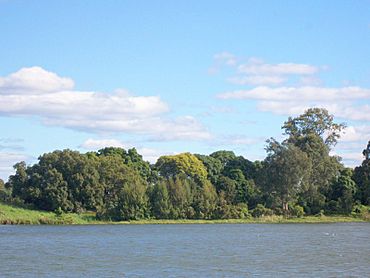Susan Island Nature Reserve facts for kids
Quick facts for kids Susan Island Nature ReserveNew South Wales |
|
|---|---|
|
IUCN Category IV (Habitat/Species Management Area)
|
|

Susan Island
|
|
| Nearest town or city | Grafton |
| Established | May 1982 |
| Area | 0.23 km2 (0.1 sq mi) |
| Managing authorities | NSW National Parks & Wildlife Service |
| Website | Susan Island Nature Reserve |
| See also | Protected areas of New South Wales |
| Geography | |
|---|---|
| Location | Clarence River |
| Administration | |
| State | New South Wales |
The Susan Island Nature Reserve is a special protected area in New South Wales, Australia. It includes Susan Island, which is a river island located in the Clarence River. This reserve is about 23-hectare (57-acre) (that's like 23 football fields!) and is close to the city of Grafton. The island is a rare example of a subtropical lowland rainforest, covering about 16.5-hectare (41-acre).
Contents
Exploring Susan Island's Nature
Most of Australia's lowland subtropical rainforests were cleared long ago for farms and houses. This makes Susan Island a very important place, as it's one of the few small patches left. The soil on the island is made of "alluvial" dirt. This means it was carried there by the Clarence River over time. The island gets about 1,080 millimetres (43 in) of rain each year. This amount is just enough for this type of rainforest to grow.
Amazing Animals of Susan Island
Susan Island is home to many different animals. There are currently eleven types of reptiles and fifteen types of mammals living here. In the past, there were even more kinds of animals. Sometimes, over 100,000 flying foxes live on the island! There are three different kinds of flying foxes, and the number of grey-headed flying foxes has been growing recently. You might also spot some special birds like the osprey and the noisy pitta.
Wonderful Plants and Trees
Did you know that 68 different kinds of rainforest trees grow on Susan Island? Some of the important trees you can find here include the stinging tree, the huge Moreton Bay fig, and the white walnut. Other cool trees are the shiny-leaved stinging tree, tulipwood, and the lacebark tree.
The biggest known yellow kamala tree grows here. It can be as tall as 30 metres (98 ft) (like a 10-story building!) with a trunk 80 centimetres (31 in) wide. Also, a plant called the white bean, which usually grows in tropical Asia, reaches its most southern natural home on this island.
Long ago, Australian red cedar trees were cut down from the island. But in 2001, the NSW National Parks & Wildlife Service helped bring them back. Now, these red cedar trees are growing well and making new seeds. There are also special programs to help the local rainforest plants grow and to stop unwanted plants (called "invasive weeds") from taking over.
Susan Island's Cultural Importance
It is believed that Indigenous Australians visited Susan Island often. They would come to collect food, plants for medicine, and fibers to make bags and nets. The island is very important spiritually to the local Gumbaygnirr people. They see it as a "Women's Site," and it is officially recognized as an Aboriginal Place under the NSW National Parks and Wildlife Act.


